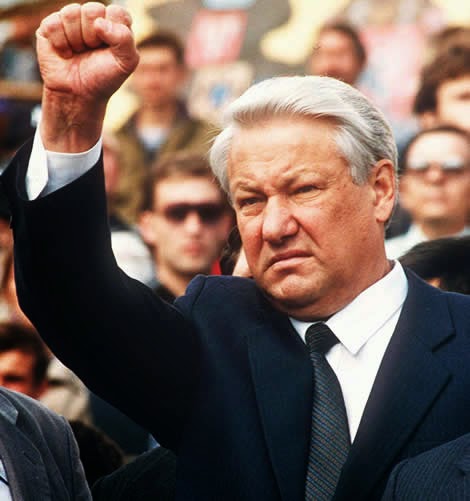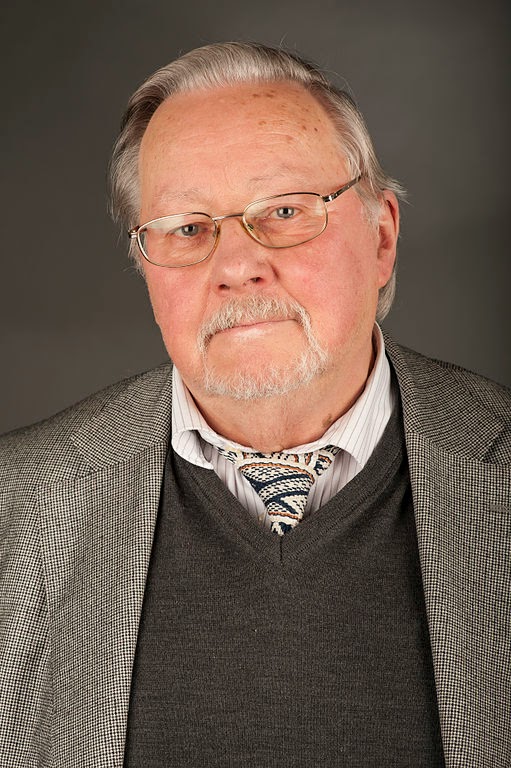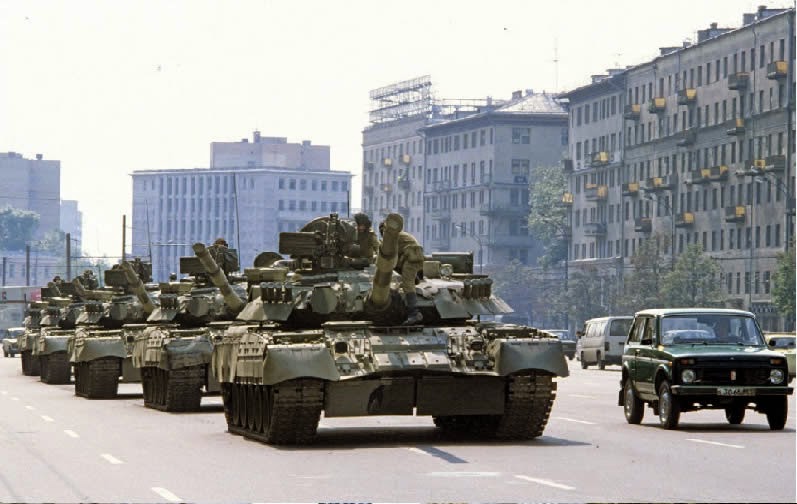In the years after 1991 Russia experienced a revolution in the name of reform. The Union of Soviet Socialist Republics had been a one-party dictatorship that strove to control all aspects of life. Its collapse unleashed a host of social forces and triggered an array of experiments as people sought simultaneously to create a democratic government, a market economy, and a civil society.
Other countries, including other remnants of the
Soviet Union, were attempting similar experiments on different scales at the same time. No one, however, had ever attempted this before, and there was no blueprint to follow.
During this period, the administration of
Boris Yeltsin would be identified with the destruction of the old structures, a struggle among alternative visions, and chaotic and sometimes contradictory efforts to build something new. The administration of
Vladimir Putin would represent a longing to reestablish order, stability, and security.
The Soviet collapse in 1991 came with remarkable rapidity. Unlike the collapse of czarist Russia in 1917, which was also sudden, this one was neither preceded by a world war nor followed by a civil war. There were relatively few violent conflicts, and those tended to be clashes between rival nationalisms.
The last Soviet leader,
Mikhail Gorbachev, had underestimated the attraction of nationalism to his country’s various constituent peoples and had overestimated people’s loyalty to the communist system.
In forcing people, officials and citizens alike, to conceal their personal beliefs as well as inconvenient political and economic facts, the Soviet system had denied its own leaders the ability to gauge the true situation and had denied people in general the possibility of fully developing their own ideas.
Gorbachev’s efforts to reform the system, in part by releasing the energies of the citizenry in the hope of using them against a sclerotic bureaucracy, resulted in the system’s demise.
Free multicandidate elections to a new national legislature in 1989 and elections to republic-level legislatures in 1990 unleashed a mass of rebellious and conflicting demands. In the course of the year, most of the republics declared "sovereignty" within the Soviet Union, that is, they asserted that republic law would henceforth be above federal law.
The Russian Soviet Federative Socialist Republic, as the Russian portion of the Soviet Union was officially known, did so on June 12, 1990. At about the same time, the media began to free itself of government control.
On the anniversary of the sovereignty declaration, June 12, 1991, while the republic was still part of the Soviet Union, Boris Yeltsin, a former Communist Party official who had fallen out with the leadership, became Russia’s first elected president.
A failed reactionary coup launched by party, military, and police officials in August 1991 was the simpulan blow in the centrifugal process that was tearing the Soviet Union apart. In the aftermath, the Communist Party was dissolved and no comparable integrative institution was created to replace it.
Yeltsin began appearing alongside Gorbachev, the Soviet president, as a coequal. Key republics, especially Ukraine, began to believe they would be better off without the "burden" of the other republics and moved toward independence. At the very least, they ceased forwarding tax receipts to the capital, compelling Russia to take over responsibility for financing central state functions.
On December 8, 1991, confronted with Ukraine’s precipitous unilateral independence, Yeltsin and the leaders of Ukraine and Belarus declared their republics a Commonwealth of Independent States (CIS), even though Russia had never formally withdrawn from the Soviet Union.
Leaders of other republics, petrified at the prospect of their sudden isolation, immediately demanded membership in the CIS as well. On December 25, 1991, Gorbachev resigned from the presidency in frustration. No one attempted to replace him, and the Union of Soviet Socialist Republics legally ceased to exist. In many ways it had already evaporated, although just when this occurred is difficult to determine.
After a brief attempt to maintain unified CIS armed forces, the republics took control of the military assets of their respective territories and created their own armies. Republics with nuclear arms stationed on their territories agreed to send them to Russia.
Each republic also acquired its portion of the assets of the Committee for State Security, which continued to exist in some form. In Russia the KGB underwent a series of renamings and reorganizations that ultimately left it as five separate entities: one each for internal security, foreign intelligence, border defense, communications security, and the personal protection of state leaders.
Redefinition With the Soviet Union gone, the next question was what would replace it. The Russian Soviet Federative Socialist Republic eventually renamed itself the Russian Federation.
The re-creation of a Russian national identity was somewhat complicated, not only by the presence of more than 120 ethnic minorities within the federation’s borders and by the fact that some 25 million ethnic Russians were now living as minorities in the 14 other successor states of the Soviet Union, but also by the fact that the pre-Soviet Russian state had included the entire Soviet territory. In the other former Soviet republics, as in Eastern Europe, the communist system could be viewed as something imposed by the Russians.
There, nationalists, anticommunists, democrats, and economic reformers could form coalitions, at least in the beginning. In the Russian Federation, although some Russian nationalists had seen the other republics as a burden, others had identified with the Soviet Union as a great power and saw its collapse as a tragedy.
Some adherents of the Soviet system and some Russian nationalists nostalgic for the old empire saw in the CIS a potential replacement that would ultimately amount to a rebirth of the Soviet Union. This never came about.
The leaders of the various republics focused on their own entities, and the CIS itself failed to develop into an alternative power center. Rather, the CIS functioned as a loose association that oversaw the peaceful severing of the numerous ties that linked the republics to one another.
Russia, not the CIS, inherited the Soviet Union’s nuclear weapons, United Nations seat, overseas embassies, and foreign debt. This, however, did not prevent Russia from pressuring the more reluctant successor states into joining the CIS during the 1990s. Only the three Baltic States remained outside.
In the early days, Russians were concerned that the unraveling might not stop with the collapse of the Soviet Union. Within the Russian Federation were former "autonomous soviet socialist republics", now simply termed "republics", regions with a substantial non-Russian ethnic population. Several of these declared sovereignty over their natural resources and asserted the primacy of their laws over federation law. Some appeared to be contemplating independence.
In March 1992 all but Tatarstan and Chechnya signed the new Federation Treaty; Yeltsin was compelled to renegotiate center-periphery relations on an ad hoc basis with several individual republics and even ethnic Russian regions. Tatarstan signed such an agreement in February 1994. In the end only Chechnya carried out the secessionist threat, triggering two wars with the Russian army.
Politically, two tendencies were prominent in the early years of Russian independence. For members of the first group, the highest-priority goals were the establishment of democratic norms and the rule of law, the creation of a viable market economy, and integration into the Western world.
For the second group, the highest priorities were building a state strong enough to defend itself, both internally and externally; assuring that national industries survived; and preserving Russian uniqueness.
Constitutionally, the form that the Russian government was to take was also under dispute. The muchamended constitution of 1978 remained in force while negotiations continued over a new Russian constitution. In this, as in economic policy, Yeltsin and the legislature took strongly opposed positions.
The legislature at the time continued the cumbersome form innovated in the Gorbachev era: a Congress of People’s Deputies, with 1,068 members, that was supposed to meet twice a year, vote on the most important issues, and elect from among its own members a smaller legislature— the Supreme Soviet—to meet between its own sessions. The constitution’s provision that the legislature was the supreme state body was not modified after the creation of the elected Russian presidency in 1991.
Crisis and Confrontation The period from the end of 1991 to late 1993 was marked by economic crisis and political confrontation that ended in bloodshed. The two poles of confrontation centered on the reformist presidency and the holdover parliament, the Congress of People’s Deputies, which fought a protracted battle over who held ultimate authority.
For the post of prime minister, Yeltsin named Yegor Gaidar, a young academic who had taught himself market economics during the late Soviet period, but the legislature refused to confirm him. Gaidar, nonetheless, continued in office as acting prime minister for one year.
The economy was in dire shape, quite apart from the normal inefficiencies of the centrally planned Soviet system. In the name of economic reform the Gorbachev government had ceased issuing orders to state-owned economic enterprises, but he had failed to establish the institutions of a market economy, resulting in a state-run system that did not work properly. The breakup of the Soviet state exacerbated the situation by disrupting economic ties between regions.
Gaidar’s response was a rapid shift, often termed "shock therapy", to free prices, balanced budgets, and monetary restraint. This went into effect on January 1, 1992, and resulted in an enormous leap in prices in addition to the already existing shortages of supply.
Normally, the shortages and rising prices should have worked as an incentive for enterprises to increase production. State enterprises, however, had not been privatized, and adequate market-based incentives had not been established.
Wholesale trade, at the time, was still widely regarded as a form of illegal "speculation". The implicit assumption that an economy dominated by gigantic plants producing military equipment could instantaneously convert to the production of consumer goods was probably naive in any event.
Managers commonly viewed the inflation as an opportunity to increase revenues while working less. When monetary restraint restricted cash flows, enterprise managers informally extended credit to each other and expended their political influence trying to get subsidies reinstated.
The Congress of People’s Deputies was the main focus of their attention. Elected in March 1990, the Congress was permeated with state-enterprise managers and former communists, most of whom now called them-selves "independents".
It repeatedly doled out payments to bankrupt enterprises, undermining the intended impact of Gaidar’s policies; issued resolutions that contradicted government policies; and threatened the president with impeachment. For his part, Yeltsin responded with the threat to establish a "presidential republic". Each side ignored the acts of the other, contributing to a growing general disregard for the law.
The personification of resistance to the president was the speaker of the Congress, Ruslan Khasbulatov; he and vice president Aleksandr Rutskoi moved steadily closer to the opposition. Both had been Yeltsin allies at the beginning of the transition.
In late 1992 Gaidar left the office of prime minister. His replacement, Viktor Chernomyrdin, was initially more acceptable to the Congress. Chernomyrdin was a hybrid bureaucrat-entrepreneur.
As minister of the gas industry, he had participated in a "spontaneous privatization" that converted the ministry into one of Russia’s largest and most profitable companies, Gazprom. Nonetheless Chernomyrdin and his finance minister, Boris Fedorov, maintained the austerity policies and even closed some inefficient state enterprises.
A referendum on economic reform and the division of power between the executive and legislative branches in April 1993 gave Yeltsin enough support to press ahead with his programs. Yeltsin and the legislature each began drawing up a new draft constitution.
The crisis came to a head in September 1993. To break the impasse, Yeltsin dissolved the Congress of People’s Deputies and called for a referendum on a new constitution and elections for a new legislature in December. Meeting in emergency session, the Congress impeached Yeltsin and declared Rutskoi president.
On Yeltsin’s order, army units surrounded the legislative headquarters on September 27, but 180 members refused to leave. After a standoff of several days, Rutskoi called for a popular uprising, which led to some street disorders but not the outpouring of support that he had anticipated.
Armed men seized the mayor’s office on October 3 and attempted to take the Ostankino television facility, where a firefight with Interior Ministry troops lasted for several hours. At this point, the army dropped the neutral position it had sought to maintain.
On October 4 tanks opened fire, and by that afternoon the rebel leaders—including Khasbulatov and Rutskoi—had emerged and surrendered. After the "October events", no parliament would defy the president so openly again. Disputes, however, were far from over.
Constitution and Elections Yeltsin’s draft constitution was approved by referendum in December 1993, in the shadow of the October events. It created a bicameral legislature, called the Federal Assembly (Federal’noe Sobranie).
The upper house, the Federation Council (Soviet Federatsii), had two members representing each of the country’s constituent regions, territories, and republics. The lower house, the State Duma (Gosudarstvennaia Duma), had 450 members, half of them elected from single-member districts and half from party lists.
The legislature was real, not a rubber stamp, but the constitution clearly gave the preponderance of power to the president. The president named the prime minister and cabinet, who were responsible to him.
The cabinet, therefore, did not have to reflect the distribution of parties in the State Duma, so there was no incentive to form coalitions to build a parliamentary majority. Initially, committee chairmanships were doled out among parties and factions in proportion to the number of seats they held.
Technically, the State Duma had the right to approve or disapprove the president’s choice for prime minister, but if it rejected three candidates it was the legislature, not the government, that was subject to dissolution. Moreover, the president had the power to issue decrees on his own.
The first post-Soviet parliamentary elections were held simultaneously with the referendum approving the constitution, two years after the collapse of the Soviet Union. A number of political organizations had essentially evaporated in the interim. The parties that did exist were often small, fractious, personalistic, and only loosely connected to the electorate.
Parties arose, combined, split, recombined, and vanished with great ease. The most substantial and organized party was the newly constituted Communist Party of the Russian Federation, although it lacked anything resembling the status and power of the former Communist Party of the Soviet Union.
The results of the elections were far from what Yeltsin and the reformers would have hoped for. The largest percentage of votes in the party-list portion of the ballot went to the Liberal Democratic Party of Russia, a misnamed authoritarian, ultranationalistic grouping with a leader, Vladimir Zhirinovsky, who was once described as a "dangerous buffoon".
The communists came in second. The reformists had split the vote by dividing into four separate parties that constantly squabbled among themselves, the two most important being Gaidar’s neoliberal Russia’s Choice and the more social-democratic Yabloko.
Despite the evident potential for renewed polarization, Russian politics did not return to the chaos of the pre-October days but settled down into a relatively normal pattern. Politicians of various stripes gradually became accustomed to open politics and even adept at it.
Despite their extremist rhetoric, the ultranationalists proved relatively supportive of the government, and the communists could be counted on for a backroom deal when the need arose. The fractious reform parties, never satisfied with compromise, often created the greatest difficulty for the reform process.
Gaidar’s original reform plan came to be implemented more consistently, without Gaidar. Prime Minister Chernomyrdin became increasingly prominent, while Yeltsin occasionally receded into the background amid rumors of drinking and the state of his health.
Economic policy was no longer undermined by subsidies granted to bankrupt factories by the legislature. Also, the privatization kegiatan made progress, although this required a presidential decree. The economic situation began to stabilize, but it did not fully recover and grow.
With new legislative elections planned in December 1995, Yeltsin eliminated elections for the upper house and determined that each jurisdiction would be represented by its governor and its legislative speaker.
He also attempted to create two new parties as the basis for a two-party system: One, a center-right organization intended to become the government party, was led by Prime Minister Chernomyrdin; the other, envisioned as a center-left loyal opposition, was led by Ivan Rybkin.
Chernomyrdin’s party, called Our Home Is Russia, managed to draw about 10 percent of the vote as long as he was prime minister. The second party, which was actually listed on the ballot as "Ivan Rybkin’s bloc", never got off the ground. The relatively poor showing, if nothing else, indicated the limits on Yeltsin’s ability to manipulate the electorate.
Forty-three parties participated in the 1995 elections, but only four of them surpassed the 5 percent threshold necessary to obtain seats under the proportional-representation system.
The four that did succeed were the Communists, the ultranationalist Liberal Democrats, Our Home Is Russia, and the social-democratic Yabloko. The Communists received the largest share this time, setting the stage for Russia’s first post-Soviet presidential election, to be held in two rounds in June and July 1996.
The Communists’ hard core of support constituted about 20–30 percent of the electorate at this time. Support was especially strong among pensioners and others who had suffered extreme hardships during the inflation and chaos of the early reform period. They had trouble, however, breaking beyond that core.
Yeltsin, who had been doing very poorly in opinion polls, ran an anti-Communist campaign and eked out a plurality of 35 percent in the first round. Communist candidate Gennadii Zyuganov finished just behind him with 32 percent. Eight other candidates were eliminated from the second round.
After hiring the third-place candidate as his national security adviser, Yeltsin then managed to consolidate the anti-Communist vote and was reelected in the second round, 54 percent to 40 percent. Significantly, all sides accepted the results of the election without protests or claims of fraud.


















